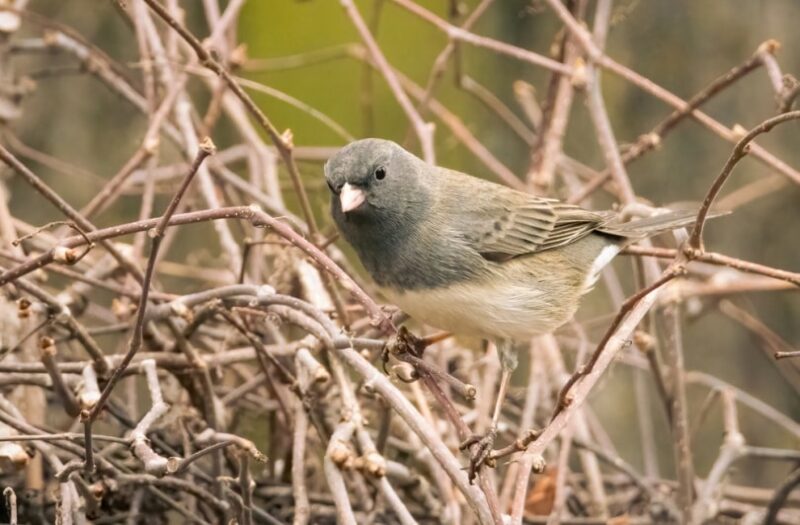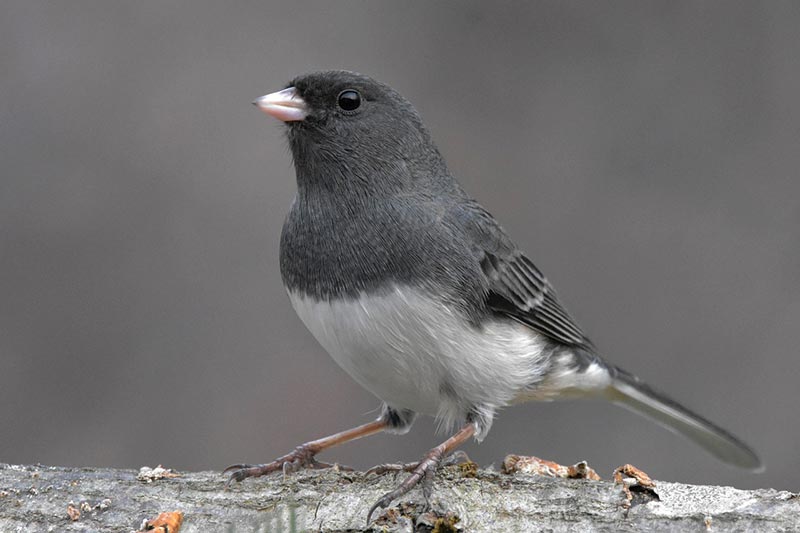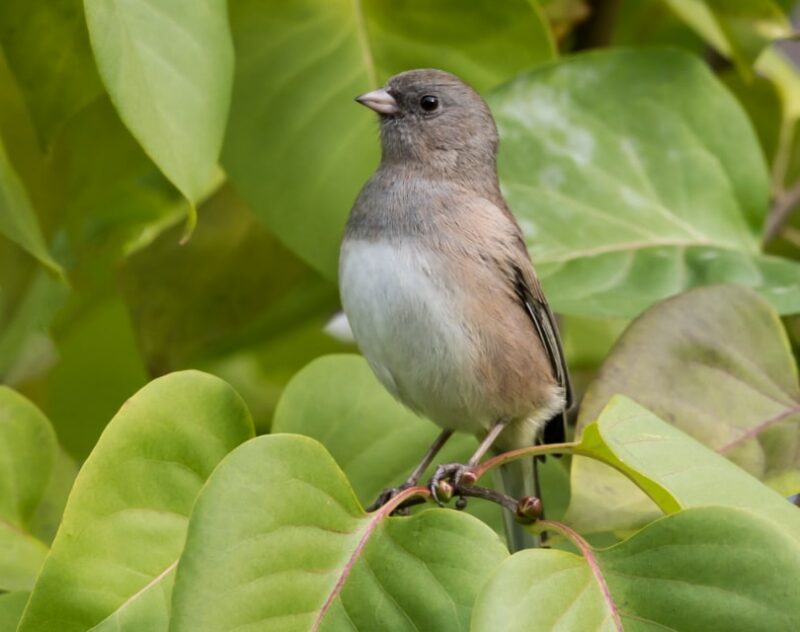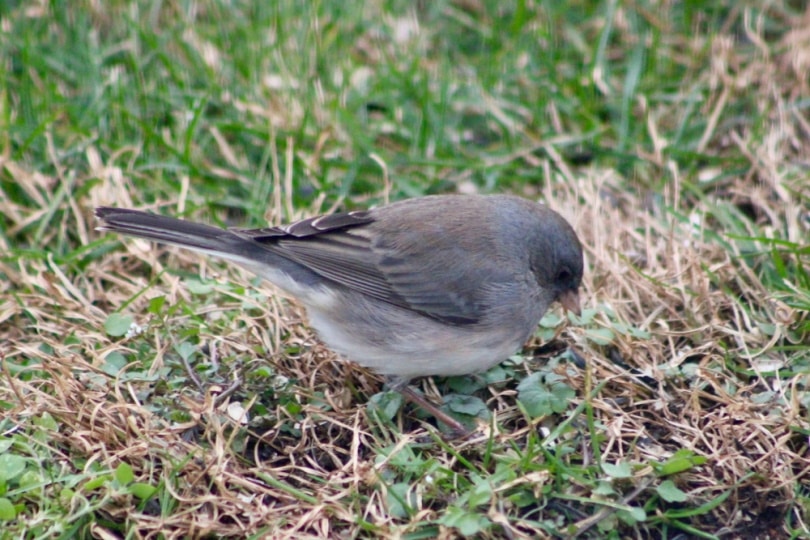Where Do Juncos Nest? Junco Nesting Habits Explained
Last Updated on

Juncos prefer living in forests across multiple areas of North America. They are also found in deciduous forests like maple, hickory, aspen, and oak. During winter and migration, they expand their usual habitats into open woodlands, parks, roadsides, and gardens. That is why you see lots of Dark-eyed and Yellow-eyed Juncos in your backyard on colder days.
Juncos are ground foragers and build nests anywhere on the ground, preferably under a log or root ball. Juncos hide their nests through overhanging vegetation, including dense plants and ferns.
Remember that they don’t nest in nest boxes but may inhabit your potted plants. To know these birds better, let’s learn more about Juncos’ nesting, courtship, and reproduction habits.

The Nesting-Building Habits of Juncos
As the breeding season gets closer, Juncos begin finding a nesting site and claiming their territory before other birds. The male usually arrives at the location before the female. Their breeding season starts anywhere between March and April.
The female is responsible for the entire nest-building process. She chooses the nesting site typically on a sloping ground, rock face, or in a depression. Juncos can nest near people, usually underneath buildings or places about 45 feet above the ground. This could include window ledges, light fixtures, or flowerpots in your backyard.
Females build the nest independently but with some help from the male. She uses her break to assemble the materials and give them a nest-like shape. The shape and size may vary depending on the location.
Sometimes, Juncos’ nests just have grass or pine needles lining. The other time, they consist of grasses, rootlets, moss, and hair built on a twig or leaf foundation. Juncos ensure their nests stay concealed against tree trunks, under bushes, grass tufts, or roots.

Their typical nest is cup-shaped, built within 3–9 days. When completed, the nest measures around 3.0–5.5 inches across, 1.6–2.8 inches in depth, and 2.4–2.8 inches in inner diameter.
There is no authentic information on if Juncos reuse a nest. But since this behavior isn’t observed much, it’s safe to conclude that whether Yellow-eyed or Dark-eyed, Juncos build a new nest every time they breed. It’s understandable since a ground nest is susceptible to damage from insects, mites, and predators.
The Mating Habits of Juncos
During courtship, males perch at a visible location and start singing. The song sounds like a simple melodious trill on a single pitch.
Juncos can get aggressive and protective of their territories and chase off other birds. Their territories measure around 2–3 acres. The courting males display wing and tail fanning while hopping up and down. During the entire mating period, males keep chirping and singing. However, they stay silent when not mating and close to their nests. Both male and female mate. Then, the female lays the eggs and the incubation period lasts until the eggs hatch.
Juncos usually stay with a single mate during the nesting season, making them a monogamous bird species. However, a few of them may choose a new partner every year. In the most literal terms, Juncos are “socially monogamous.” This means they stay with one mate, raise the nestlings, and may mate with other Juncos in nearby areas.
In fact, a female doesn’t wait long after losing their mate. Instead, they quickly mate with their neighbor, who already has their own nestlings to take care of. These female Juncos stay “single mothers” and raise their nestlings independently.
Juncos, especially the dark-eyed ones, first breed when they are a year old. They give birth to two nestlings each year (could be three). During this time, their main predators (rodents) keep a keen eye on the eggs and offspring.

The Eggs of Juncos
| Clutch Size | 3–6 eggs at a time |
| Number of Offsprings | 1–3 |
| Egg Length | 0.8–0.8 inches (1.9–2.1 cm) |
| Egg Width | 0.6–0.6 inches (1.5–1.6 cm) |
| Incubation Period | 12–13 days |
| Nestling Period | 10–13 days |
| Egg Appearance | Pale bluish white, totally white, gray, or pale-greenish white with brown, green, or gray spots. They can be unmarked too. |
Juncos lay eggs as soon as March starts. Typically, they nest up about three times in one season, so they’re likely to have eggs in their nests till August. Their clutch size ranges from three to six eggs, usually four to five. The earlier the clutches, the more eggs will be.
The timing of egg-laying may differ depending on the state. For example, Junco’s nests in Oregon are usually spotted from April 25th to the early days of August. However, lowland nesting occurs way before this period in the mountains.
Similarly, Juncos in the San Diego County mountains build nests from April 18th and feed the nestlings from May 13th. However, the birds living along the coast build nests from February and feed their last nestlings between August and September.
The eggs of Juncos have distinct brown speckles on their bigger ends. They differ in color too, ranging from white to gray base color with a touch of blue or green. The size of the eggs is approximately 0.8 inches in length and 0.6 inches in width. The incubation duty solely relies on the females that continue for about 11–13 days before the hatching day.

The Nestlings or Babies of Juncos
The nestlings of Juncos hatch naked and depend on their parents. They remain in their home for more than a week, about 10–13 days, before leaving it. Both parents find food for the babies, mostly small insects, and feed them for about 3 weeks.
When the nestlings reach the juvenile plumage, they leave the nest. They look like brown sparrows with the same color streaks on the chest. Their tails have flashing white feathers. They also give twittering calls to tell the parents they are ready to be on their own.
Baby Juncos show juvenile plumage for about 2–3 months. After that, they turn into adult plumage with more flashing white tail feathers.
Do Juncos Build Nests in Nest Boxes?
Juncos don’t use nest boxes for nesting. So, if you plan to attract these birds to your yard by installing nest boxes, don’t implement them. Instead, focus on placing large flower pots or hanging them above the ground. Juncos are likely to nest in these areas.
However, that doesn’t mean they don’t use nest boxes entirely. An article from the Wilson Journal of Ornithology reported the first nesting of a Junco in a nest box in Washington in 2016. That’s how occasional it is for most New World sparrows to use nest boxes.

To attract Juncos to your backyard, you must keep the environment natural and clean. For instance, plant spruce trees near the ground, allowing tall grass to grow in the surrounding area. This may make Juncos interested in nesting in your backyard.
You can also grow dense bushes or a flower garden to provide nesting grounds for these birds. But make sure to protect them from predators.

Final Thoughts
Juncos are ground foragers that build their nests on the ground. They are widespread in North America’s forests, woodland, parks, and gardens. The females primarily choose the nesting site and build on their own with some help from the males.
The Junco couple builds a nest within 3 to 9 days. Their clutch size is about three to six eggs at a time, with 12–13 days of incubation and 10–13 nestling days.
If you suspect Junco’s nesting in your backyard, it’s better to leave it as is. Otherwise, you may make a path that predators can follow to reach their nests.
Featured Image Credit: Luc Pouliot, Shutterstock
About the Author Jeff Weishaupt
Jeff is a tech professional by day, writer, and amateur photographer by night. He's had the privilege of leading software teams for startups to the Fortune 100 over the past two decades. He currently works in the data privacy space. Jeff's amateur photography interests started in 2008 when he got his first DSLR camera, the Canon Rebel. Since then, he's taken tens of thousands of photos. His favorite handheld camera these days is his Google Pixel 6 XL. He loves taking photos of nature and his kids. In 2016, he bought his first drone, the Mavic Pro. Taking photos from the air is an amazing perspective, and he loves to take his drone while traveling.
Related Articles:
10 Types of Hummingbirds in Arkansas (With Pictures)
8 Types of Hummingbirds in Nebraska (With Pictures)
5 Types of Hummingbirds in Idaho (With Pictures)
3 Types of Hummingbirds in Mississippi (With Pictures)
8 Types of Hummingbirds in Kansas (With Pictures)
5 Types of Hummingbirds in West Virginia (With Pictures)
5 Types of Hummingbirds in Ohio (With Pictures)
Where Do Nuthatches Nest? Nuthatch Nesting Habits Explained
